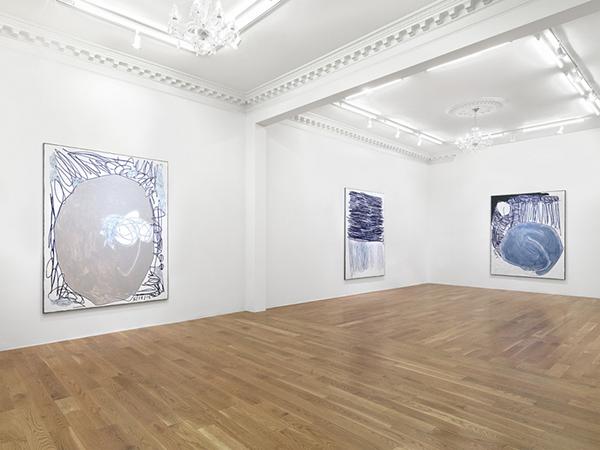Massimo De Carlo London is currently presenting ‘Rob Pruitt: Therapy Paintings’. Following on from his previous show ‘suicide paintings’, Pruitt has now produced doodles from his therapy sessions blown up to fill large canvases and then overpainted.
In the late 1910s, members of the budding Surrealist movement began to experiment with a new method of mark making, initially practiced by Freudian psychoanalysts, called ‘automatic drawing.’ A means of exploring, expressing, and picturing the unseeable character of the human subconscious, the technique involved the surrendering of the mind’s conscious faculties, allowing the hand, instead, to pass over paper with nothing but the arbitrary guidance of the psyche’s whims. Artists would use the method to access repressed memories and emotions, and later depict these privileged recollections in artistic form, conjoining all manner of uncanny images into new, otherworldly compositions.
The pursuit of automatism, and the pure form of expression it untethered, became a crucial artistic activity and objective for many of the most significant artists of the twentieth century, as well as a totemically important concept in the development of Modern Art. Influenced by its initial Surrealist practitioners, such as André Breton and Salvador Dalí, later artists such as Jackson Pollock and Cy Twombly practiced their own versions of automatist expression, creating compositions that, while abstract, still viscerally evinced the respective emotions, personalities, passions, and caprices of their makers.
The artist’s series of Therapy Paintings places the artist into conversation with these artistic forebears, adopting their conceit of automatic writing while also, crucially, updating its tenets and technology to suit the present day. Akin to the automatic drawing of a hundred years ago, the designs featured on the impastoed surfaces of the paintings likewise stem from Pruitt’s own hand, their shape determined by his emotions and subconscious. Building upon this legacy, however, Pruitt produces these drawings during his therapy sessions, enhancing the very conditions of automatism, as his drawings stem literally, figuratively, and physically from a space of mental ‘working through’—his own brain and his analyst’s office, simultaneously.
Each with its own shape, its own story, the designs populating Pruitt’s Therapy Paintings come to embody the many emotions felt not only by the artist himself, but by any viewer, any human. They are offered without explication, left for each viewer to interpret. Yet despite this enigmatic presentation, the designs are evocative, familiar. A jagged edge might recall anger; a buoyant mass, elation. The paintings allow the viewer to enter the most private and intimate of spaces, and in an act of utter vulnerability, access the artist’s own psyche alongside him. We are there with him as we view these paintings. We understand him. Uncannily, viewing them, it’s as if he understands us too.
“I call this series the Therapy Paintings, because the linear information printed onto each impastoed surface is generated during weekly visits to my therapist. I’ve seen a therapist for a good part of my adult life, and even though I’m quite comfortable on the couch, the act of speaking un-self-consciously about myself had always been difficult, even in this sanctified environment. That changed when I began bringing a pocket-sized notepad and pen with me to my sessions. Letting the pen scribble across the paper automatically was like opening up a valve in my brain, allowing me to speak with greater ease. At the time, I never saw these drawings as anything more than the residue of my progress with my therapist. But then I began to recognize how, by capturing and containing the emotional energy that I was feeling at the time, they could become the basis for a type of abstract painting that I have long wanted to explore.” Rob Pruitt.
About the artist:
Rob Pruitt was born in Washington, DC, and studied at the Corcoran College of Art and Design in Washington, DC, and Parsons School of Design in New York. His work has been included in numerous museum exhibitions, including an encompassing exhibition at the Brant Foundation in Greenwich, CT (2015), a 2013 mid-career retrospective at the Aspen Art Museum, a solo exhibition at Dallas Contemporary (2011), Museum of Contemporary Art, Detroit (2015), Freiburg Kunstverein (2012); Le Consortium, Dijon (2002); and group shows such as “Empire State” at the Palazzo delle Esposizioni, Rome (2012), “Pop Life” at Tate Modern (2009), and “Mapping the Studio” at Punta Della Dogana/Palazzo Grassi, Venice (2009). In 2009, he debuted the “Rob Pruitt’s Art Awards,” at the Guggenheim Museum, an award show for the art world fashioned after the Oscars. In 2011, he was commissioned by the Public Art Fund to install “The Andy Monument,” a highly polished chrome sculpture of Andy Warhol (replete with shopping bags) in New York’s Union Square near the site of Warhol’s Factory.
ROB PRUITT : THERAPY PAINTINGS – MASSIMO DE CARLO LONDON – until 30 January, 2016.

